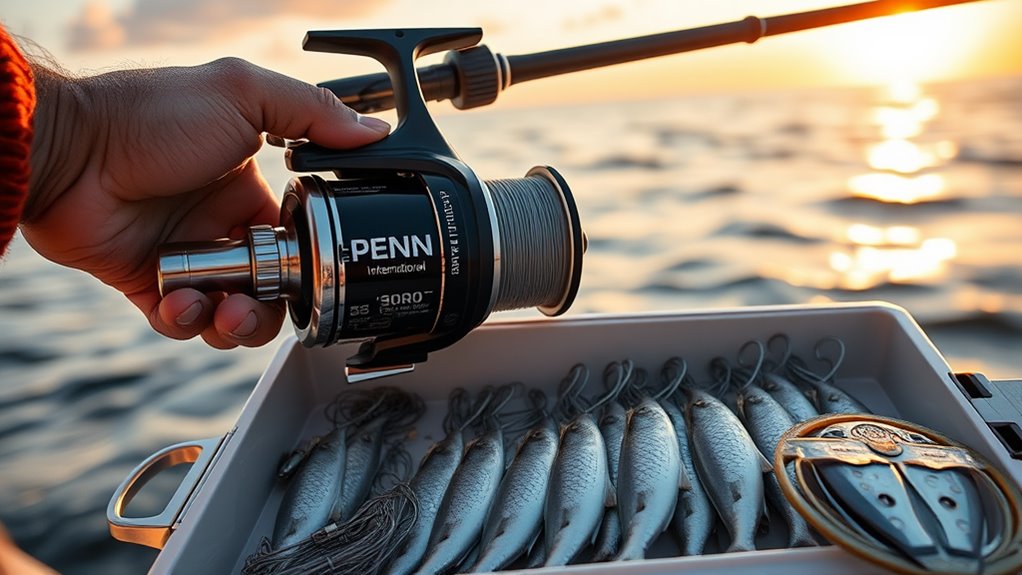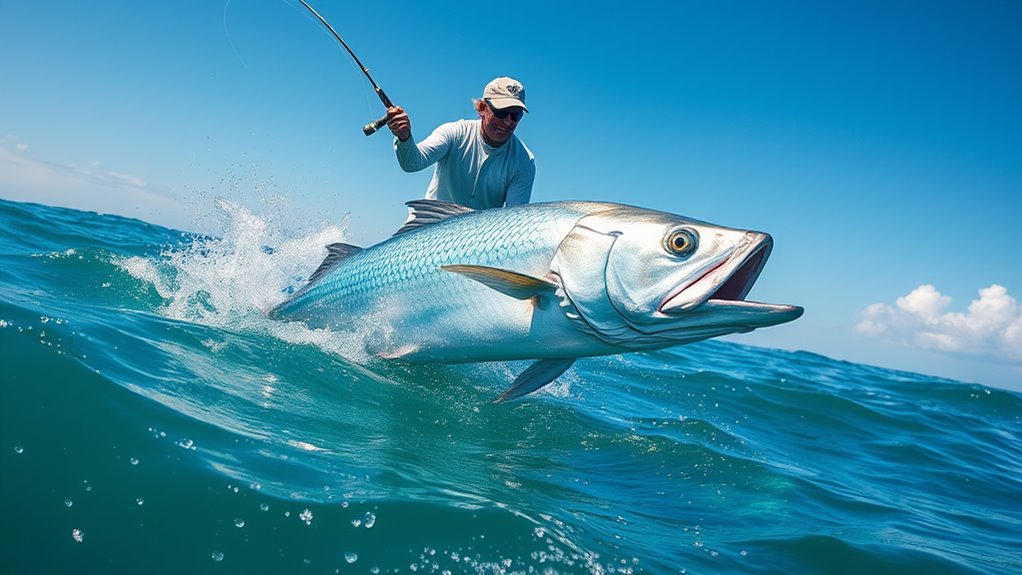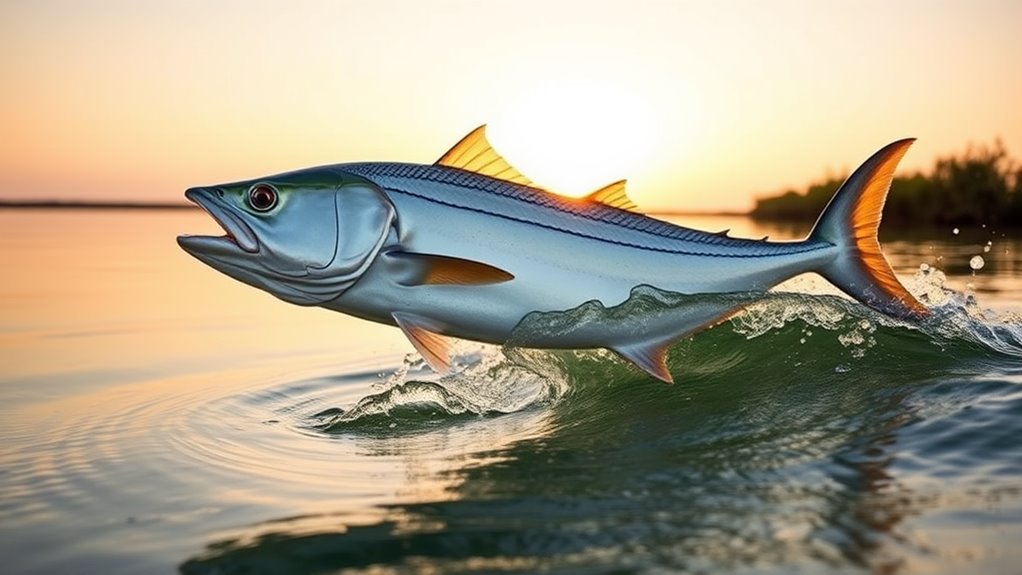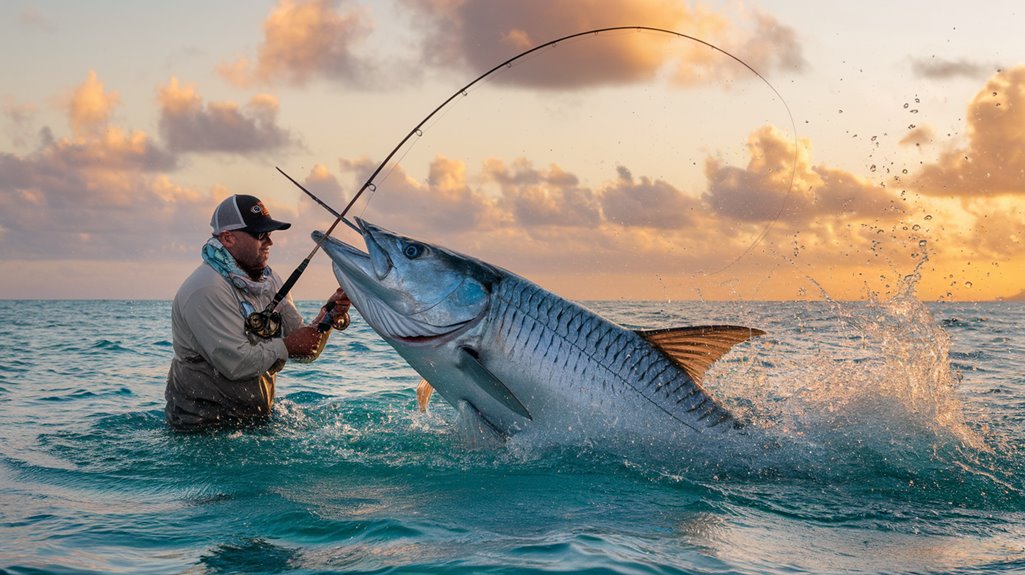To catch trophy tarpon, you'll need a 7-8 foot heavy spinning rod paired with a 6000-8000 size reel and 30-50 lb test line. Use wide gap circle hooks with live bait like mullet or crabs, and maintain a 45-degree rod angle while fighting. When the tarpon jumps, bow to the fish by dropping your rod tip. Focus on fishing Florida's coastline from April to August, targeting areas where flats meet deeper channels during tide changes. These fundamentals will set you up for landing the silver king.
Key Takeaways
- Use a 7-8 foot heavy spinning rod with 30-50 lb test line and an 80 lb fluorocarbon leader for proper gear setup.
- Let tarpon swim with dead bait before setting hooks, maintaining a 45-degree rod angle during the fight.
- Drop the rod tip during jumps to provide slack line, preventing breakage during aerial displays.
- Fish during tide switches near oceanside sand holes and channels where flats meet deeper water.
- Use wide gap circle hooks for dead bait and live crabs, while J-hooks work best for mullet and soft plastics.
Essential Gear Selection for Trophy Tarpon

The five essential pieces of gear can make or break your tarpon fishing success. You'll need a 7-8 foot heavy or extra-heavy spinning rod paired with a 6000-8000 size reel to handle trophy tarpon effectively. Select line weight between 30-50 lb test to withstand powerful runs and jumps during the fight. Attach a 6-foot fluorocarbon leader of at least 80 lb test to protect against the fish's rough mouth and potential shark encounters. Wide gap circle hooks give you the best chance for proper hook placement while reducing injury risks during catch and release. For bait, 8-inch live mullet or small whiting prove highly effective at attracting these powerful gamefish. With this specialized gear setup, you're well-equipped to land that trophy tarpon you're after.
Live Bait Strategies and Techniques
Successful live bait fishing for tarpon requires mastering specific presentation techniques and reading subtle bite indicators. You'll need to adapt your approach based on your chosen bait type and fishing conditions.
| Bait Type | Hook Type | Technique |
|---|---|---|
| Live Mullet | J-hooks | Use bobber with 6-8' leader |
| Live Crabs | Circle hooks | Wait for strong bumps |
| Dead Bait | Circle hooks | Monitor slack in line |
| Bottom Fishing | Circle hooks | Let fish swim with bait |
| Soft Plastics | J-hooks | Hold rod for sensitivity |
When you're using live mullet, watch their behavior closely as they'll signal nearby tarpon. With crabs, wait for pressure on the line before setting the hook. For dead bait presentations, maintain some slack in the line while monitoring your rod tip. Remember that circle hooks are essential for proper mouth placement, regardless of your bait choice.
Mastering the Art of Hook Setting

While landing a tarpon requires considerable skill, mastering proper hook-setting technique often determines whether you'll boat the fish or lose it at the first jump. Circle hooks are essential for effective corner-mouth placement, maximizing your chances of a successful catch.
- Let the tarpon swim off with dead bait before reeling in to guarantee proper hook placement
- Set the hook with a steady thump rather than an aggressive strike
- Maintain a 45-degree rod angle while fighting the fish, dropping the tip during jumps to prevent slack line
- Start with loose drag settings and adjust gradually throughout the fight
Your success rate will improve notably by focusing on these hook-setting fundamentals. Remember that proper technique prevents lost fish and increases your chances of landing these powerful gamefish.
Navigating Tarpon Jumps and Runs
When you see a tarpon launch into its spectacular aerial display, you'll need to immediately bow to the fish by dropping your rod tip toward the water, giving the line enough slack to prevent the hook from tearing free. After the jump, quickly raise your rod to a 45-degree angle and prepare for the inevitable power run that follows. You'll want to maintain steady pressure during these extended runs while strategically changing your rod angles to keep the fish off balance and ultimately gain the upper hand.
Bow For Aerial Displays
To master a tarpon's signature aerial displays, you'll need to execute the "bow to the king" technique with precision timing. When you see the fish break the surface, quickly drop your rod tip to reduce line tension and prevent the hook from pulling free. Keep your drag settings moderate throughout the fight to handle sudden post-jump runs effectively.
- Drop your rod tip immediately when the tarpon begins its aerial display
- Maintain a low rod position during the jump to minimize dangerous slack
- Raise your rod back to 45 degrees once the fish re-enters the water
- Change your fighting angles frequently to disorient the fish and shorten the battle
This strategic approach to managing jumps will greatly increase your chances of successfully landing these magnificent gamefish.
Managing Extended Power Runs
Beyond mastering aerial displays, successful tarpon fishing requires expert handling of their powerful sustained runs. When fighting a fish, you'll need to maintain precise control while adapting to their explosive movements. Keep your rod tip pointed directly at the fish during initial runs to manage line effectively, then shift to a 45-degree angle to re-establish tension once the fish settles.
Remember to give slack and "bow to the king" during jumps by lowering your rod tip – this reduces pressure on the fish and prevents break-offs. To tire the tarpon more quickly, change the angle of your rod position frequently. This strategic manipulation disorients the fish and helps shorten the fight. Maintaining a tight line is essential, but always be ready to adjust your technique as the tarpon alternates between powerful runs and aerial displays.
Strategic Locations and Timing

Since tarpon follow predictable migration patterns, you'll find the best fishing opportunities along Florida's coastline from April through August, with May and June offering peak action. Target these strategic locations during tide switches, particularly in early morning or late evening when visibility peaks.
- Scout for rolling fish near oceanside sand holes and channels, as this behavior indicates active groups of tarpon
- Position yourself in clear water areas with minimal wind for ideal sight fishing
- Focus on residential canals and backwaters when seeking juvenile tarpon outside peak months
- Look for areas where flats meet deeper channels, especially during tidal movement
Set yourself up for success by combining prime locations with ideal timing. The intersection of these factors, along with proper water conditions, greatly increases your chances of connecting with these powerful gamefish.
Fighting Tactics for Different Size Classes
When battling small tarpon in the 5-40 pound range, you'll need to maintain a light drag setting and keep your rod at a 45-degree angle to control their acrobatic displays effectively. For trophy-sized tarpon exceeding 100 pounds, you must employ heavier drag settings and alternate your rod angles every 20 seconds to wear down these powerful fighters. You'll maximize your chances of landing both size classes by pointing your rod directly at jumping fish, reducing line tension and maintaining better control throughout the fight.
Trophy Tarpon Battle Strategies
Although trophy tarpon require different battle strategies based on their size, mastering the fundamentals of rod control and pressure management remains essential for landing these powerful gamefish. To catch large tarpon effectively, you'll need a 6000-8000 size reel paired with an extra-heavy rod that can handle intense battles.
- Keep the line tight and maintain a 45-degree rod angle to control the fish's movements
- Change your fighting angles frequently to disorient the tarpon and reduce fight duration
- Apply steady pressure while avoiding high-sticking during their acrobatic jumps
- When fighting smaller tarpon, point your rod directly at the fish to absorb sudden runs
Your success in landing trophy tarpon depends on proper gear selection and consistently executing these technical fundamentals throughout the fight.
Small Fish Fighting Methods
Landing smaller tarpon demands a distinct set of techniques compared to their trophy counterparts. You'll need to maintain tension by pointing your rod straight at the fish, avoiding the common mistake of high sticking. Keep your drag settings soft to prevent excessive strain while still maintaining control of the line.
When fighting these smaller specimens, don't make the error of pulling hard. Instead, keep your rod tip low and at no more than a 45-degree angle to effectively tire the fish. As tarpon are known for their aerial displays, let the fish jump by providing slack line. To increase your chance of landing the catch as quick as possible, change angles frequently during the fight. This strategy disorients the fish and helps you gain the upper hand while maintaining proper pressure throughout the battle.
Frequently Asked Questions
What Is the Best Rig for Tarpon Fishing?
Use 30-50 lb test line with an 80 lb fluorocarbon leader, wide gap circle hooks, and a sliding sinker fish-finder setup. You'll want larger live baits for best tarpon results.
What Is the Best Bait to Catch Tarpon?
Hungry for success? You'll catch more tarpon using live mullet around 8 inches long. Butter perch, whisker minnows, and small whiting work well too. Fresh-cut ladyfish serves as effective dead bait.
How to Catch a Tarpon Fish?
Use 30-50 lb test line with circle hooks, rig live mullet or cut ladyfish, and target rolling fish during peak months. Lower your rod during jumps to maintain tension.
What Attracts Tarpon?
You'll attract tarpon with schools of mullet, shrimp, and small baitfish in clear waters. They're drawn to struggling prey, surface activity, warm water temperatures, and overcast conditions during migrations.
Conclusion
As you've mastered these battle-tested tarpon techniques, you're now armed like a skilled gladiator entering the arena. The silver king's airborne acrobatics and blistering runs won't catch you off guard anymore. You'll predict their moves like a chess master, equipped with the right gear and proven tactics. It's time to put this knowledge into action – the mighty tarpon awaits your challenge.

